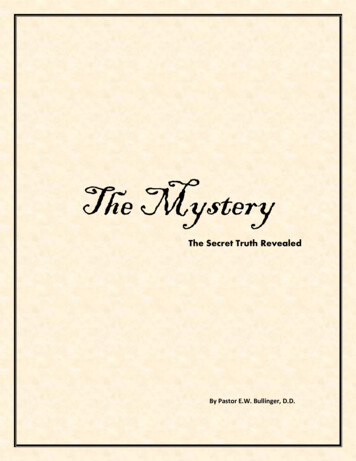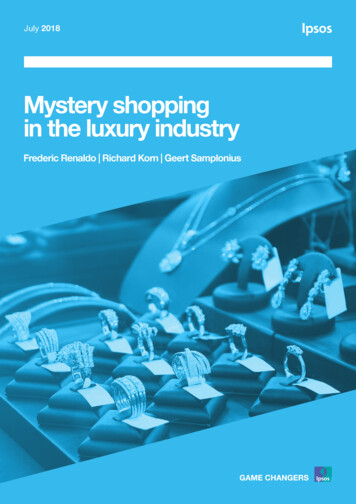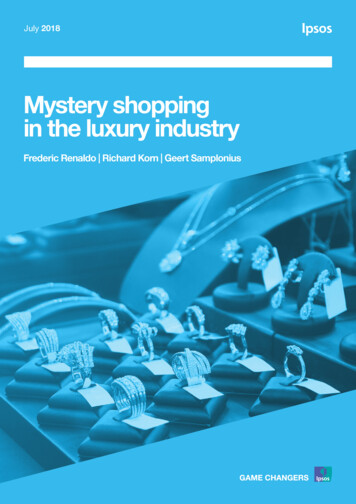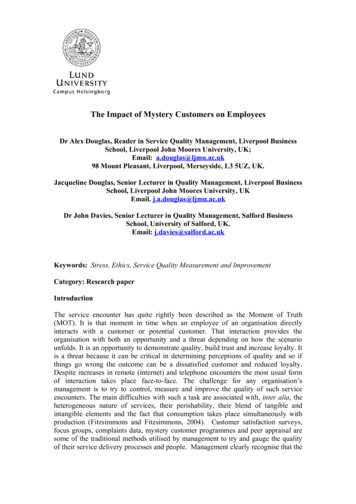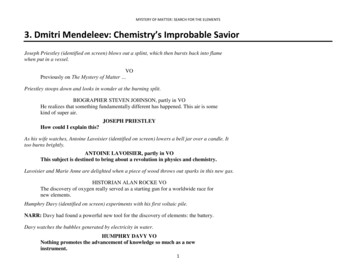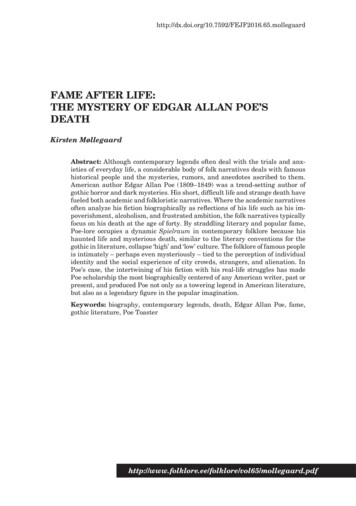
Transcription
ME AFTER LIFE:THE MYSTERY OF EDGAR ALLAN POE’SDEATHKirsten MøllegaardAbstract: Although contemporary legends often deal with the trials and anxieties of everyday life, a considerable body of folk narratives deals with famoushistorical people and the mysteries, rumors, and anecdotes ascribed to them.American author Edgar Allan Poe (1809–1849) was a trend-setting author ofgothic horror and dark mysteries. His short, difficult life and strange death havefueled both academic and folkloristic narratives. Where the academic narrativesoften analyze his fiction biographically as reflections of his life such as his impoverishment, alcoholism, and frustrated ambition, the folk narratives typicallyfocus on his death at the age of forty. By straddling literary and popular fame,Poe-lore occupies a dynamic Spielraum in contemporary folklore because hishaunted life and mysterious death, similar to the literary conventions for thegothic in literature, collapse ‘high’ and ‘low’ culture. The folklore of famous peopleis intimately – perhaps even mysteriously – tied to the perception of individualidentity and the social experience of city crowds, strangers, and alienation. InPoe’s case, the intertwining of his fiction with his real-life struggles has madePoe scholarship the most biographically centered of any American writer, past orpresent, and produced Poe not only as a towering legend in American literature,but also as a legendary figure in the popular imagination.Keywords: biography, contemporary legends, death, Edgar Allan Poe, fame,gothic literature, Poe gaard.pdf
Kirsten MøllegaardThe boundaries which divide Life from Deathare at best shadowy and vague.Who shall say where the one ends,and where the other begins?Edgar Allan Poe (2004c: 357)SITUATING EDGAR ALLAN POE’S FAME IN ACADEMIC ANDPOPULAR IMAGINATIONThe death, in particular the violent or sudden death, of famous people canproduce a new ‘life’ for them in the popular imagination. They become legendaryin the cultural landscape: their lives and accomplishments are sentimentalizedor aggrandized; their homes are reverted to shrines and become sites forpilgrimages; their personal effects are prized by collectors and exhibited inmuseums; their inner lives are continuously analyzed, demonized, embellished,or scrutinized in many types of expressive media (film, books, performances)ranging from scholarly studies to blogs; and their portraits, signature artifacts,and photographic poses are visually branded onto objects of material culturethrough the endless process of copying, printing, and re-printing images oncommercial merchandise and souvenirs. In Celebrity, sociologist Chris Rojekobserves, “The fact that media representation is the basis of celebrity is at theheart of both the question of the mysterious tenacity of celebrity power and thepeculiar fragility of celebrity presence” (2001: 16). Media-driven post-mortemfame may in fact overshadow the level of fame, or popular celebrity, the personachieved while alive. This is certainly the case for the American author EdgarAllan Poe (1809–1849), whose afterlife in both academia and popular cultureincludes an impressive corpus of belief narratives surrounding his death, whichovershadow the level of his fame in real life. Today Poe is considered the founderof the detective genre, the master of gothic horror, and the most influentialAmerican writer of the Romantic Movement. His works include the classicsThe Raven, The Fall of the House of Usher, the Dupin murder mysteries, The Pitand the Pendulum, The Premature Burial, The Tell-Tale Heart, The Black Cat,The Gold Bug, The Cask of Amontillado, The Masque of Red Death, and manyother gothic tales of dark mysteries, horror, madness, and spectacular violence.No other American writer has had as enduring and pervasive an influence on popular culture as Poe has. To claim that “everybody knows Poe”, asJ. W. Ocker does in Poe-Land: The Hallowed Haunts of Edgar Allan Poe (2015:10), is hyperbole, but not entirely false either. Poe’s fame uniquely spans fromthe ivory tower of academia to the gutters of B horror movies. To mention a few130www.folklore.ee/folklore
Fame after Life: The Mystery of Edgar Allan Poe’s DeathFigure 1. Edgar Allan Poe, 1848. Photograph by W. S. 796/).examples that illustrate “Poe’s ambiguous position between highbrow and lowbrow culture” (Neimeyer 2002: 208): busts and statues of Poe alongside othercanonized literati adorn learned institutions and libraries across the US, but outof all those celebrated writers only his image appears on the cover of The Beatles’ 1967 album Sgt. Pepper’s Lonely Hearts Club Band; a National FootballLeague team, the Baltimore Ravens, takes its name and logo from Poe’s poemThe Raven; cartoon characters like Garfield and Bart Simpson have recitedPoe’s works; many horror films, including B-movie cult classics starring VincentPrice, draw their inspiration from Poe’s works; the US postal service has issuedFolklore 65131
Kirsten Møllegaardtwo commemorative stamps of Poe in 1949 and 2009; women’s magazines likeBetter Homes and Gardens give seasonal advice on how to make a Poe-inspiredHalloween dinner; original Poe memorabilia, letters, and manuscripts fetch sixand seven-digit prices at auctions, while mass-produced souvenirs like coffeemugs, refrigerator magnets, baby bibs, and mouse pads sell for considerablyless. The list goes on, and so does Poe’s afterlife, as expressed by a devoted fan:“Never RIP, Edgar Allan Poe” (Ocker 2015: 360).Poe’s dynamic afterlife is fueled by two seemingly incongruous, yet mutually influential forces: Poe’s tenacious popularity and visual presence in popculture, and his canonized influence on literary genre, which ensures that everyAmerican high school student will have read some of his works, most commonlyThe Raven and The Fall of the House of Usher. Since the focus of this articleis on Poe as a haunting presence in the popular imagination, there will be noattempt to separate the “academic Poe and the pop-culture Poe” (Peeples 2004:125). Rather, this article will investigate the overlap between the folkloric andthe academic in the narratives surrounding Poe’s death and, broadly speaking,consider how popular fascination with fame contributes to the production ofcontemporary folklore. Poe-lore is invested with social fears of death and desires for fame; it hovers precariously between actual events and the signifyingpractices of storytelling; and, when seen as an example of Michel de Certeau’soutline of discourse formation, Poe-lore authorizes a Spielraum (room for freeplay) in the popular imagination for negotiating the knowable, the mysterious,and the poetic in everyday life (Certeau 1984: 91–114).As Jan Bondeson argues in Buried Alive: The Terrifying History of Our MostPrimal Fear, Poe drew generously on folktales and legends in his horror stories.Bondeson even declares that the theme of premature burial was an ‘unwholesome fascination’ and ‘obsession’ for Poe (2001: 208, 214). In general, writers doof course draw on material from everyday life for their literary endeavors, butBondeson’s remarks serve as an important reminder that Poe’s fame is intertwined with a perceived image of him in the public sphere as mentally deranged,mysteriously dark, unwholesome, and obsessed with morbid themes, while heis celebrated in scholarly circles for his originality and generic innovations.Poe’s fame is thus situated in the dynamic realm of the popular (including popular literature), where there is “contestation between various culturalforces in which hegemony and resistance, conformity and subversion, may beproduced” (original emphasis, Blanco & Peeren 2010: xii). The tension betweenthose contesting cultural forces energizes both Poe scholarship and Poe’s continuing presence in popular urban legends, rituals, and performances. However,scholars primarily see celebrity as “a modern phenomenon, a phenomenon ofmass-circulation newspapers, TV, radio and film” (Rojek 2001: 16). Norbert132www.folklore.ee/folklore
Fame after Life: The Mystery of Edgar Allan Poe’s DeathRuebsaat contends, “Celebrity, as we know it today, was created by modernmass media” (2007: 9). However, today’s media-driven celebrity cult is historically related to the production of rumors, legends, tall tales, and similar folknarratives. Like contemporary legends, narratives about famous people “are toldas true, or at best plausible, and . are mirrors of cultural values” (Møllegaard2005: 41). The social production of Poe’s fame is thus intimately related to thefolkloric aspect of urban and contemporary legends because fame hinges on thetelling of stories that, for better or worse, are “too good to be true” (Brunvand1999: 19). Fame as well as ill fame is associated with narrative processes ingeneral and with telling stories in particular. In Roman mythology, the goddessFama (Pheme in Greek mythology) personified rumor, gossip, and endless curiosity about the lives of others. In The Aeneid, book IV, Vergil describes Famaas a winged creature with many eyes, ears, and wagging tongues. Fama is notconcerned with what is true or false: “Her claws hold both true news and evillies. / She filled the realms now with her tangled talk, / chanting in glee a mixof fact and fiction” (Vergil 2008, lines 188–190). According to the Oxford English Dictionary, the root words for the Greek name Pheme and the Latin Famarelate to the derivative colloquial word for ‘speak’ or ‘talk’, fabulare (OED 1989:703–704). This etymology suggests that fame is a multifaceted concept, whichincludes, on the positive side, public renown, good reputation, and celebrity asmeans to achieve high social status and, on the negative side, ill fame, scandal,and bad reputation, and consequently the expulsion from ‘good’ society.Poe’s posthumous fame is not only media-driven; it is also performative andinformed by vernacular expressions of folk beliefs and folklife (chiefly in theform of tourism). Although Poe lived in an era far removed from contemporaryreputation generators like the tabloid press, blogs, Twitter, Facebook, etc.,rumors and anecdotes that related facts or fiction about a person’s good or badreputation – either in print or by word of mouth – were powerful social tools ofcontrol in antebellum USA. In his lifetime, Poe was considered a controversialfigure in literary circles. He was not uniformly recognized as a literary geniusalthough he actively tried to become a famous writer. As Mark Neimeyer pointsout, Poe “clearly, though largely unsuccessfully, sought popular success duringhis lifetime” (2002: 207). Scott Peeples acknowledges that “certainly Poe wasalert to the way reputations are manufactured” (2004: 25), but he also notesthat Poe’s irrational, confrontational behavior often undermined his own bestinterests. Suggestive as these remarks are about Poe’s own agency in fabricating a public reputation, it is important to recognize that Poe’s public personaand his astounding posthumous fame as the enfant terrible of American letterswere produced, and continue to be produced, by a combination of scholarly andlay interest in his life and works.Folklore 65133
Kirsten MøllegaardSome scholars attribute Poe’s posthumous fame to his proverbial self-destructiveness, that is, his self-identified “imp of the perverse”, which is the urgeto “do wrong for wrong’s sake only” (Poe 2004b [1840]: 350). J. Gerald Kennedy captures the essence of Poe’s reputation when stating that Poe’s “sheerperverseness, his urge to locate and confront enemies, to offend and disgust,to mock and mystify, ensured that Poe would remain (as on some level hedesired) the obnoxious misfit of American letters, the bad boy of the antebellum literary world” (Kennedy 1996: 535). Virtually all Poe scholars agree thatPoe’s successor as editor of Graham’s Magazine, Rufus Griswold, committedcharacter assassination against Poe immediately after his death by writinga scathing, vindictive obituary describing Poe as dishonest, alcoholic, immoral,mentally deranged, conceited, decadent, and without friends (Peeples 2004: 2).Ironically, it seems, Griswold’s defamation of Poe launched the so-called ‘PoeLegend’ and thus contributed to Poe’s posthumous fame in significant ways(Ljungquist 2002: 7).A BRIEF OUTLINE OF POE’S LIFEIn order to situate the legends about Poe’s death in a biographical context,a brief synopsis of his life and literary themes is in order. Edgar Poe was bornin Boston, MA, to itinerant actors on January 19, 1809. In 1811, his fatherDavid Poe abandoned the family and died a year later, leaving wife ElizabethArnold Poe destitute with three young children: Henry, Edgar, and Rosalie.Elizabeth died of tuberculosis in Richmond, VA, just before Christmas in 1811,when Edgar was two years old. The children were divided up amongst fosterfamilies. Edgar was taken in by a wealthy tobacco merchant, John Allan andhis wife Frances, and his name was legally changed to Edgar Allan Poe. Poegrew up in relative affluence, but as he grew into manhood, he and John Allandeveloped an increasingly contentious relationship and fought over money. In1827 Poe’s foster mother Frances died of tuberculosis. At the age of twenty,Poe was completely estranged from his foster family and virtually penniless.He had to quit University of Virginia after one semester, and after a two-yearstint in the army at West Point, he became an editor and literary critic andtried to make a living as a writer. When he was twenty-seven, he married histhirteen-year-old cousin Virginia Clemm. She died of tuberculosis twelve yearslater, in 1847. They had no children. Although Poe had difficulty getting his workpublished and never made much of a profit from it – for example, he only earned 9.00 from his masterpiece poem The Raven – his poetry and short stories were134www.folklore.ee/folklore
Fame after Life: The Mystery of Edgar Allan Poe’s Deathin fact well received during his lifetime. The death of the three women closestto him from tuberculosis – his mother, foster mother, and wife – is a vital partof the tragic aura of his biography; but it is also an essential element of hisphilosophy of composition and underlies his famous dictum, “the death, then,of a beautiful woman is, unquestionably, the most poetical topic in the world”(Poe 2004e [1845]: 680).Poe’s life was emotionally difficult, financially turbulent, and markedby periods of sobriety alternating with periods of excessive drinking, manicbehavior, and possible drug use. He fought with editors and had trouble keepinga job. The Poe household included Edgar, Virginia, and her mother MariaClemm. They moved frequently. Their living quarters have been traced toseveral addresses in Baltimore, Richmond, Philadelphia, and New York. Poewas very much an urbanite, and many of his most haunting short stories – forexample, The Man of the Crowd, The Murders in the Rue Morgue, and TheImp of the Perverse – evoke the social experience of urban space and crowds,menacing strangers, and existential alienation in the city.Poe’s fictional cityscapes are fraught with existential chasms of Angst, conjuring ghostly shadows and imaginary geographies haunted by death. In TheImp of the Perverse, for example, the narrator, who is basking in felicity overhaving committed a cruel murder and gotten away with it, is walking downa busy street when he is suddenly overcome by paranoia. He thinks he seesthe ghost of the man he murdered. Terrified, he starts running: “I boundedlike a madman through the crowded thoroughfares. But now the populace tookalarm and pursued” (Poe 2004d [1845]: 406). He is roughly detained by thecrowd and hysterically blurts out his confession. Similarly, the claustrophobicsqueeze of crowds upsets the narrator in The Man of the Crowd, who observeshow “dense and continuous tides of population were rushing past the door”(Poe 2004a [1845]: 233). He spends the night obsessively following an old manthrough filthy labyrinthine streets, in the rain, in a nightmarish attempt toescape the crowds by becoming swallowed up in the whirlpool of humanity.Poe’s fiction in general is haunted by images of death, madness, and violence,but his dark cityscapes loom large over the legends and theories that attemptto explain how Poe died. Fatefully, Poe’s own death in Baltimore appears tohave been framed exactly as he envisioned in his fiction by a maelstrom of busy,dirty streets, rough-handed struggle, and mental torment.Poe’s death at the age of forty, in 1849, has been the subject of intensedebate and speculation, spawning not only a large number of scholarly booksand papers, but also inspiring an annual nocturnal ritual by a disguised agentknown as the Poe Toaster.Folklore 65135
Kirsten MøllegaardPOE’S DEATH: FACTS AND THEORIESThe elusive search for what caused Poe’s death has generated many types ofnarratives and a great deal of media interest. Some narratives build on thorough archival investigations, others attempt to glean a medical diagnosis fromthe fragmentary documents describing Poe’s final days, and some are mainlyspeculative. While the scholarly production of narratives pertaining to Poe’sdeath is both ingenious and in many instances very well argued, to this day itremains inconclusive what exactly Poe died of.What is known for a fact is that Poe had left Richmond, VA, for Philadelphia, PA, on September 27, 1849. There is no verifiable evidence about hiswhereabouts or activities between September 27 and October 3, 1849, whenhe was found semiconscious and delirious in front of a voting poll in Baltimore,MD, dressed in ill-fitting clothes not his own. An urgent note from a printernamed Joseph Walker to Dr. Joseph Evan Snodgrass at Washington CollegeHospital states, “There is a gentleman rather the worse for wear, at Ryan’s 4thward polls, who goes under the cognomen of Edgar A. Poe, and who appearsin great distress & says he is acquainted with you, he is in need of immediateassistance” (Thomas & Jackson 1987: 844). Four days later, on October 7, 1849,Poe died at the hospital.There are several accounts about what transpired between Poe being foundat Ryan’s tavern and his death at the hospital, but they are not entirely clear.Dr. Snodgrass went to the polling station and immediately recognized Poe’sface, “although it wore an aspect of vacant stupidity that made me shudder”(Thomas & Jackson 1987: 844). Dr. Snodgrass tried to procure a room for Poeat the tavern, but the innkeeper refused to accommodate him due to Poe’s “abusive and ungrateful” behavior (ibid.). Poe was sent to the Washington CollegeHospital. Dr. Snodgrass relates, “So insensible was he, that we had to carryhim to the carriage as if a corpse. The muscles of articulation seemed paralyzedto speechlessness, and mere incoherent mutterings were all that were heard”(Thomas & Jackson 1987: 845). Dr. Snodgrass’ testimony comes from his articleDeath and Burial of Edgar A. Poe, which was published in May 1856, sevenyears after Poe’s death. Dr. Snodgrass appears to have muddied the clarity ofwhat transpired at the hospital. Robert Hopkins explains that Dr. Snodgrasswas a strong proponent of temperance and “a religious zealot who, from theearly 1850s, preached the gospel of Poe’s death as a result of the sin of a dissolute life as a drunkard” (2007: 43). To warn against the ill effects of alcohol,he even falsified the content of Walker’s emergency note in order to presentPoe’s condition as the result of overconsumption of alcohol: “whereas Walkerspoke of a ‘Gentleman, rather the worse for wear,’ Snodgrass substituted ‘ina state of beastly intoxication’” (Brandy 1987).136www.folklore.ee/folklore
Fame after Life: The Mystery of Edgar Allan Poe’s DeathAt the hospital, Poe was erratic and had to be restrained. Dr. John J. Moran,the resident physician, reported that on the fourth day Poe called out for someone named Reynolds, the identity of whom is not known, though some scholarsbelieve that Poe alluded to Jeremiah N. Reynolds, the South Sea explorer,whose travel accounts had inspired Poe to write his only novel, The Narrativeof Arthur Gordon Pym of Nantucket (1838), (Walsh 1999: 122). On October 7,Poe said a short prayer – “Lord, help my poor soul” – before he died. Dr. Moranrelated this account in a letter dated November 15, 1849, to Poe’s mother-in-lawMaria Clemm. He concluded that Poe died from delirium tremens. Accordingto Dr. Moran, Poe was beset by violent deliriums, at one point saying that “thebest thing his friends could do would be to blow out his brains with a pistol”(Thomas & Jackson 1987: 846). However, W. T. Brandy questions Dr. Moran’strustworthiness (Brandy 1987). Dr. Moran later went on speaking tours andpublished articles, in which he changed and embellished many of the statementshe had initially made in the letter to Mrs. Clemms. Kenneth Silverman sums up:The cause of Poe’s death remains in doubt. Moran’s account of hisprofuse perspiration, trembling, and hallucinations indicates deliriumtremens, mania à potu. Many others who had known Poe, including theprofessionally trained Dr. Snodgrass, also attributed his death to a lethalamount of alcohol. Moran later vigorously disputed this explanation,however, and some Baltimore newspapers gave the cause of death as“congestion of the brain” or “cerebral inflammation.” Although theterms were sometimes used euphemistically in public announcementsof deaths from disgraceful causes, such as alcoholism, they may in thiscase have come from the hospital staff itself. According to Moran, one ofits senior physicians diagnosed Poe’s condition as encephalitis, a braininflammation, brought on by exposure. (1991: 435–436)No autopsy was performed, and Poe was buried in an unmarked grave at Westminster Hall and Burying Ground in Baltimore two days later, on October 9,1849. Today, a headstone marks this spot. Twenty-six years later, in 1875, Poe’sremains were moved to a new prominent grave in front of the church. Ten yearsafter that, in 1885, the remains of his wife Virginia, who had been buried inNew York, and mother-in-law Maria, who had died in 1871, were also placedin the new grave. The imposing monument that marks this grave is where theso-called Poe Toaster, who will be discussed below, for fifty years placed threered roses and an opened bottle of cognac on Poe’s birthday, January 19.Poe’s pauper burial and the cryptic death diagnosis, congestion of the brain,have given rise to considerable speculation about what actually caused Poe’sdeath. The Edgar Alan Poe Museum in Richmond offers a comprehensive,though not exhaustive, chronological list of proposed theories of Poe’s deathFolklore 65137
Kirsten Møllegaardcause and the year they were proposed: beating (1857), epilepsy (1875), dipsomania (1921), heart disease (1926), toxic disorder (1970), diabetes (1977),hypoglycemia (1979), alcohol dehydrogenase (1984), porphyria (1989), deliriumtremens (1992), rabies (1996), heart attack (1997), murder (1998), epilepsy(1999), carbon monoxide poisoning (1999), and brain tumor (2007) (Museum2014). Considering the rather long-term progression of some of these diseasesand conditions, it is remarkable that Poe wrote in a letter the year before hisdeath: “My health is better – best. I have never been so well” (cited in Kennedy2001: 55).An Internet search produces multiple websites speculating on the possiblecauses of Poe’s death in both scholarly databases and popular websites. Thescholarly sources tend to include detective work in Poe’s papers and letters,along with examination of his contemporaries’ letters. However, even in thescholarly sources there happens to be a rather laissez-faire use of medicalterminology, resulting in some bizarre diagnoses of what caused Poe’s death.Hopkins, for example, refers to the possibility that Poe suffered from “sclerosisof the liver” (2007: 42), possibly confusing sclerosis with cirrhosis. Beyond aca-Figure 2. Poe’s original grave. Westminster Hall and Burying Ground, Baltimore, lklore
Fame after Life: The Mystery of Edgar Allan Poe’s Deathdemic databases, in more accessible venues like Wikipedia and Open Culture,for example, speculations about Poe’s death include – in addition to the causesjust mentioned – suicide, murder, cholera, influenza, and cooping as possiblecauses for his death. Cooping refers to the 19th century practice in Americanpolitics of forcing a person to vote, under the threat of violence or the effects ofdrugs or alcohol, often several times, for the same candidate. Since cooping ofteninvolved changing the cooped person’s clothes so that he might pass for someoneelse, this theory addresses the mystery of why Poe was wearing someone else’sclothes when he was found at the tavern polling station.All these speculations over the last 150 years have contributed to the scholarly lore of American literary biography. From a folklore perspective the circulation and consumption of these theories provide a case study of the mysteriesand anxieties associated with the confluence of famous people and the urbangothic in everyday culture. “Poe’s death is one of the biggest literary mysteries,period,” argues Matthew Pearl in an interview with The Observer. “People don’tgrow tired of it. It’s sort of like the J.F.K. assassination” (Neyfakh 2007). Pearl,by the way, believes that Poe died from a brain tumor.Pearl’s reference to the 1963 assassination of President John F. Kennedyis an important clue to understanding why Poe’s death continues to fascinatescholars. The violent death of famous people elevates them to emblems of tragedy in the public imagination. In a study on the popular deification of PrincessDiana by Gillian Bennett and Anne Rowbottom (2009), the authors identifythe dual forces of news media and folk sentiments as driving the modern-dayhagiography of figures like Grace Kelly, Elvis Presley, Eva Peron, James Dean,Marilyn Monroe, and Jimi Hendrix. In Poe’s case, however, the news mediatend to play a secondary role compared to the power of sentimental scholarly,perhaps pseudo-scholarly, investment in mystifying Poe’s death. For example,while his death at the age of forty is often seen as suspicious and tragic, lifeexpectancy for white American males in 1850 was actually only 38.3 years (LifeExpectancy 2007). The sensationalism with which these death theories arelaunched, complete with morbid details, tends to fuel and romanticize ratherthan solve the mystery of Poe’s death. For example, Pearl’s theory that Poedied of a cancerous brain tumor is based on newspaper articles printed one tothree years after Poe’s remains had been reburied, that is, twenty-seven totwenty-nine years after he died. The state of his remains would likely havedeteriorated considerably, but witnesses to the reburial stated that Poe’s brainwas still visible inside the skull and looked “dried and hardened” (Harris 2007).Pearl relates that “one account described the brain as almost rattling aroundinside Poe’s head” (ibid.). After consulting a friend whose wife is a doctor, Pearlconcludes that Poe died from a brain tumor that had calcified after his death.Folklore 65139
Kirsten MøllegaardIt needs mentioning that scholars who launch sensational theories about Poe’sdeath may be motivated by pecuniary interests. Pearl’s novel, The Poe Shadow(2007), received mediocre reviews, but because of the popular interest in anything pertaining to Poe’s melodramatic life, Pearl was interviewed in leadingnewspapers in the United Kingdom and the United States and thus able topromote his book.More in the vein of occultism, in the years after Poe’s death there wererumors claiming that the author’s spirit posthumously tried to contact SarahHelen Whitman, a woman with whom he was romantically involved in thelast couple of years of his life. Whitman supposedly hired a psychic medium,Lizzie Doten, who published poetry she claimed Poe’s ghost had dictated toher fourteen years after his death. More recently, efforts to vindicate Poe’sreputation as an alcoholic have prevailed. In addition to wooing Whitman, Poehad a romantic liaison with the wealthy widow Sarah Elmira Royster Shelton,with whom he purportedly was engaged to be married in 1849 (Walsh 1999:106–123). Based on rumors that Shelton’s family opposed her plans to marryPoe, historian John Evangelist Walsh proposes that Shelton’s three brotherswent to Baltimore, restrained and plied a sober Poe with alcohol, dressed himin someone else’s clothes to make him look like a victim of cooping, and lefthim in dire condition at the tavern, where Dr. Snodgrass later recovered him.THE POE TOASTERScott Peeples observes:Scholars in recent years have been paying more attention to what mightbe called ‘the Poe effect’, the creation and maintenance of Poe’s image, thevarious ways this image interacts with popular culture and with Poe’swriting. As Mark Neimeyer puts it, ‘the popular exploitation of Poe can beseen as adding another dimension to the element of the uncanny alreadypresent in the author’s writings since these productions are all strangelyPoe and not Poe at the same time’ (222). (2004: 126)The mysterious Poe Toaster is one the most dynamic and performative aspectsof the Poe Legend (the corpus of narratives pertaining to his life and works) andits effect on popular culture. The Poe Toaster began a ritual of toasting Poe athis grave on the night of January 19, Poe’s birthday, and leaving an open bottleof cognac along with three roses. This ceremony has been recorded with someuncertainty back to 1949, the centennial of Poe’s death (Society n.d.). It ended140www.folklore.ee/folklore
Fame after Life: The Mystery of Edgar Allan Poe’s Deathin 2009, the 1
Edgar Allan Poe (2004c: 357) SITUATING EDGAR ALLAN POE’S FAME IN ACADEMIC AND POPULAR IMAGINATION The death, in particular the violent or sudden death, of famous people can produce a new ‘life’ for them in the popular imagination. They become legendary in the cultural lands



